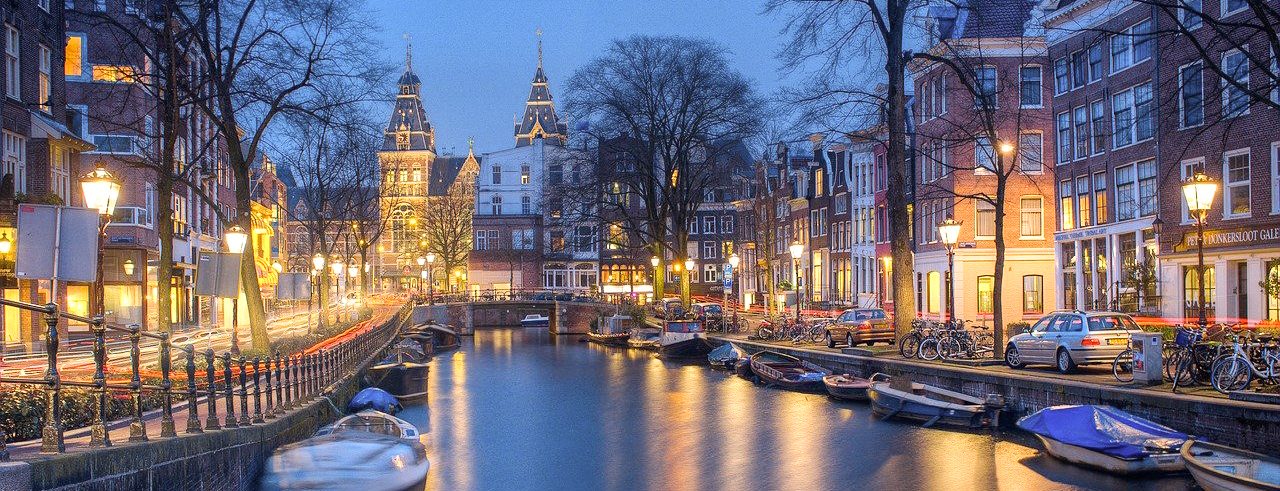Visiting Istanbul: The Good, The Bad, and The Startling
This post may contain affiliate links. If you make a purchase through these links, we will earn a small commission at no extra cost to you. For more information, please check our privacy policy. Thanks!
As the first step in writing this post, I thumbed through my photos of Istanbul. Steve and I sure saw a lot of beautiful things there. Despite that, it is our least favorite city. So what made us dislike Istanbul so much?
It all comes down to the extremes; beautiful neighborhoods surrounded by ghettos, decent public transportation but hard-to-find information, and a modern Airbnb in a building that caught fire.
In this post, I will share the good, the bad, and the startling things about visiting Istanbul.
All money is in U.S. dollars
A Little Background
During the summer and fall of 2022, Steve and I spent eleven weeks in Turkey. During the first six weeks, we visited six cities on the Mediterranean Coast, aka the Turkish Riviera, enjoying a side of Turkey we had no idea existed. Then we spent one week in Cappadocia. Hiking and a sunrise balloon ride were the highlights of that trip. We ended our Turkish tour with four weeks in Istanbul.
Check out our other Turkey posts:
“6 Cities, 6 Vibes on the Turkish Riviera”
“18 Things to Know Before Visiting Cappadocia”
“Turkey is for Cat Lovers.”
A Little Istanbul Geography
Istanbul is divided by the Bosphorus Straight. The western side is in Europe, while the eastern side is in Asia. Most of the tourist attractions are on the European side, and this impacts the lodging costs. Airbnbs on the Asian side were more modern and lower priced, so we decided to split our four weeks between the two continents.
The Good
Incredible Museums
The Topkapi Palace Museum
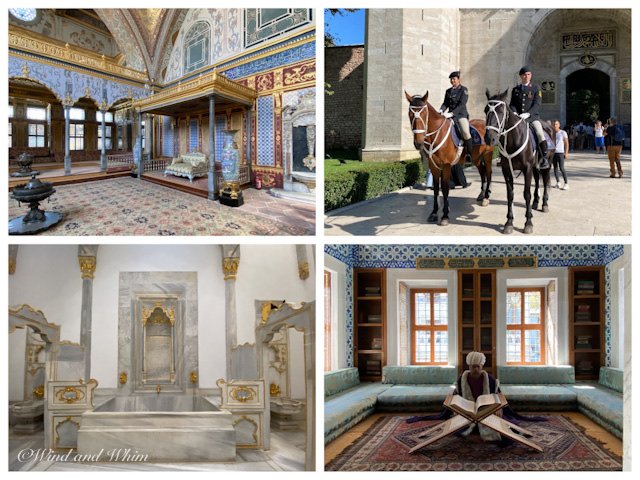
The Topkapi Palace is on the European side of Istanbul on the shore of the Bosphorus Straight where it meets the Sea of Marmara. It is a large complex with much to see.
The palace served as the administrative center of the Ottoman Empire and the home of Ottoman sultans from the 1450s until the 1850s. At that time, the newly built Dolmabahce Palace became the home of the sultans.
Don’t miss the harem. It was the quarters for the imperial family and its servants. The word harem means forbidden or private.
You can read more about the harem here.
The Dolmabahce Palace

The Dolmabahce Palace is as impressive as the Topkapi Palace. It was built as a replacement for the Topkapi Palace, designed to match the luxury and style of European palaces.
The palace was completed in 1856. It was the home of six sultans until the founding of the Turkish Republic in 1923.
Like the Topkapi Palace, it is on the European side of the city on the Bosphorus Straight, but further north.
The Basilica Cistern
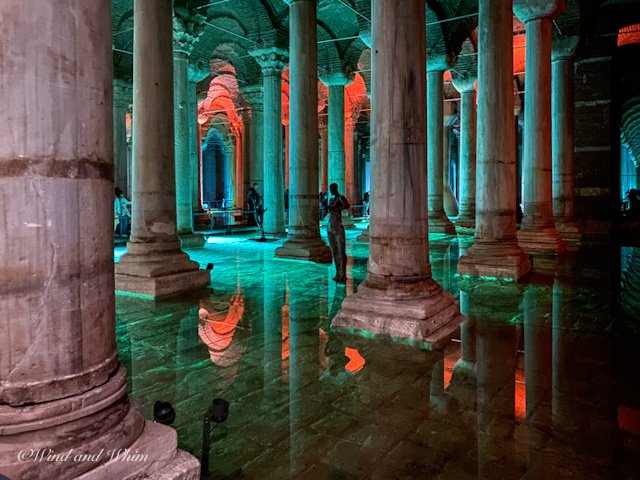
You might not think that touring a cistern would be entertaining. Still, the stately architecture of the Basilica Cistern, highlighted by changing colored lights and sculptures, makes for an enjoyable visit with great photo ops.
This cistern was built in the 6th century. It is the largest of several hundred built beneath the city to meet the water needs of the people.
The Kucuksu Palace

Like the Dolmabahce Palace, the Kucuksu Palace was built in the mid-1850s by Sultan Abdulmecit I for use as a hunting palace.
The palace is on the Asian side of the city and quite a bit further north. There are only nine rooms and no bedrooms. Guests would only visit for the day.
An audio-guided tour takes less than one hour. Once you have seen the palace and the small garden area, you can take a ferry across the straight using the IstanbulKart, and visit the Rumeli Fortress.
Rumeli Fortress
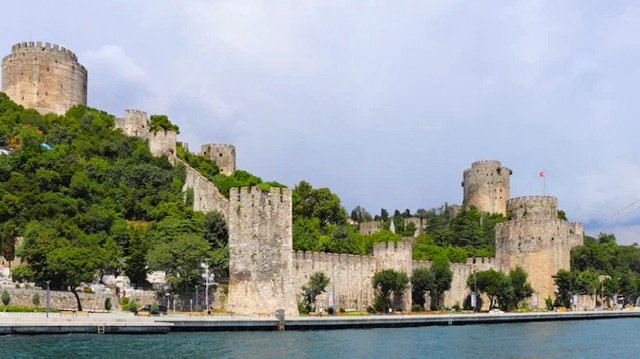
The 30-acre Rumeli Fortress sits along the Bosphorus Straight on the European side of Istanbul. Sultan Mehmed II built this imposing fortress before he conquered Constantinople (the name of Istanbul until 1930) in 1453.
Renovation work was going on when we visited, but the areas we could see made for a nice change from the opulence of the other sights.
Panorama 1453 Museum

The Panorama 1453 Museum illustrates the conquest of Constantinople by Sultan Mehmed II (Mehmed the Conqueror) in 1453. Despite the limited scope of the subject, this is an interesting museum.
First, you will find a series of photos that explain the events leading up to the conquest. Then you will enter the 38-meter-wide (124-foot) panoramic dome showing scenes of the city’s conquest.
Hagia Sofia and The Blue Mosque

Both of these famous mosques are in Sultanahmet. While we were visiting Istanbul, the Blue Mosque was undergoing renovations, so we could only see one small part. However, the Hagia Sofia was open.
The Hagia Sofia has a fascinating history. It was built in the 6th century as an Eastern Orthodox church. After the conquest of Constantinople in 1453, it was converted into a mosque. In 1935 it became a museum, and in 2020 it returned to being a working mosque.
You can visit the Hagia Sofia anytime during opening hours, but if you go during prayer hours, you will not be allowed in the prayer section. There are five prayer times each day, and the time changes. You can get the current information here.
The Blue Mosque is a baby compared to the Hagia Sofia. It wasn’t built until the 17th century.
Its official name is the Sultan Ahmed Mosque, but it is called the Blue Mosque because the inside is decorated with handpainted blue tiles.
The Balat Neighborhood

If you like exploring quirky neighborhoods, don’t miss Balat. Like much of the city, there are a lot of hills. However, they seemed even steeper here. If you’re up to walking on some severe inclines, this area is sure to delight you.
The People – Individually
Taxi Driver
Taxi drivers have a reputation for ripping off tourists. We were lucky to get an honest one.
We had spent the day exploring and found ourselves far from home at rush hour. We decided to take a bus home. When we arrived at the stop, it was mobbed.
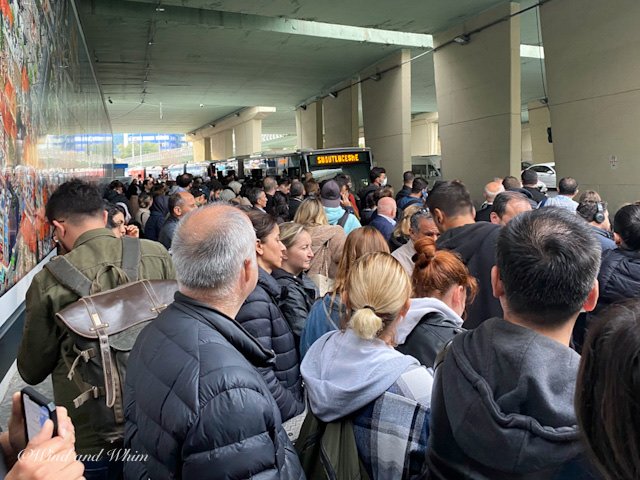
There were hundreds of people waiting to get on the express buses that went from the European side to the Asian side. Each time a bus approached, our hope rose, only to have it dashed as the bus drove by, unable to carry any more passengers.
We decided that a taxi was a better option. At first, the driver didn’t want to drive us because of the distance and the time it would take. Luckily, he took pity on us, explained it would be a slow ride, and quoted us a fare of $20.
It was a slow ride indeed. He kept the meter running, and I watched as it climbed over the amount quoted to $48. I wasn’t nervous until it exceeded the amount of cash we were carrying.
Once we arrived home, I asked him to wait while I ran upstairs and got more cash. He said we only owed him the $20 he had quoted. We gave him the $45 we had. We could see the relief on his face.
Lesson learned: We had never needed more than a few dollars in cash, usually for a tip. That experience taught us to carry more cash.
Impromtu Crossing Guard
Another person who warmed our hearts was an older man sitting on a chair by a store. He saw us attempting to cross a busy street at a crosswalk. The cars weren’t stopping, so he got up, walked into the street, and held up his hand to stop traffic.
It worked. However, as I reached the other side of the road, I almost got hit by a driver who lacked patience. That sums up Istanbul perfectly.
The Metro
Istanbul has an extensive subway system consisting of eight lines (six on the European side and two on the Asian side). There is also a tunnel called the Marmaray that connects the European and Asian lines.
To use the metro and other forms of public transportation, you need to buy an IstanbulKart and put some money on it. Then it’s just a matter of swiping it as you enter the vehicle or the terminal.
Here is a good article about public transportation in Istanbul.
The Cost
Outside of the high cost of lodging in Sultanahmet, you get a lot for your money in Istanbul. We used public transportation extensively. Our average cost was $6 per day. We ate eighteen meals out with an average cost of $30 for the two of us. These included main dishes, drinks, and a tip.
You can see what four weeks in Istanbul cost below.
Inexpensive Medications
While we were in Istanbul, both Steve and I needed to refill a few prescriptions. I assumed this would require a trip to a doctor’s office, but one day Steve discovered that we could get all our medications without a prescription.
I bought three months’ worth of all five of my medications for less than $100. Without insurance, two of them would cost over $500 each for a one-month supply in the U.S.
The Bad
Even though there are many remarkable things to see in Istanbul, several things detracted from our enjoyment.
The Slums
Right from the start, Istanbul played tough.
Initially, we wanted to stay in the Sultanahmet area, near the main tourist attractions. We spent hours combing through Airbnb and Booking.com listings, but there weren’t any places in our price range where we would be willing to stay.
However, there was an apartment in a new building in the Beyoglu neighborhood that caught our eye. It was a little far from the tourist area, but we were willing to spend a little travel time to stay in an attractive, affordable place.

The apartment was everything we expected, at least inside. What the listing didn’t show was the garbage-filled lot outside our window and the trashy buildings across the way.
That was bad enough, but our building was in a row of about eight new high-rises. Everything else, in every direction, was slums. If we wanted to go anywhere, either by foot or to catch a bus, we had to walk through some terribly run-down neighborhoods.
Despite all the negatives of the area, we never felt unsafe, and nobody bothered us.
During the last two weeks of our trip, we stayed in the Kadikoy neighborhood on the Asian side of the city. It is filled with beautiful high-rise buildings and is more upscale than Beyoglu. Our view improved this time; we looked out at another high-rise under construction.

Lesson learned: We now use Google Street View to check the surrounding neighborhood of any accommodations we are considering.
The Crowds
Over 15 million people live in Istanbul. Add the tens of millions who visit each year, and you have massive overcrowding. Walking around the city was often a contact sport as people going in both directions refused to give an inch.
Here is information from World Population Review about the most heavily populated cities in the world.
Lesson learned: Crowded cities are not our thing. We will either avoid them or limit our stay in the future.
The Traffic
Congestion and aggression are two constants on Istanbul streets. There is also a confounding disregard for lane markers. Twice we had long taxi rides in which the drivers seldom stayed in their lanes.
There are a lot of motorcycles, which makes things even more chaotic. Motorcycle drivers in Istanbul ignore the fact that they are motor vehicles. It is common to see them run red lights, drive down crowded streets in the wrong direction, and drive on sidewalks.
Impassable Sidewalks
While walking in the city, you often have to walk in the street because the sidewalks are impassable. Cars, restaurant tables and chairs, and any number of other things block them. Sometimes they may be so poorly constructed that the street is a safer option.

The Buses
Istanbul has an extensive bus network, and Google Maps did a good job providing information. However, the buses seldom arrived when they were supposed to. They could be early or late. Basically, you stand at the stop and wait for your bus to show up.
Once on board, you will probably get to know your fellow travelers better than you would like. We were on one bus that was so crowded that a few people sat on other passengers’ laps, and up to ten people had to get off the bus to let other passengers off.
Lack of Information
The entire time we were in Turkey, we noticed that it was harder to find information online than expected. We found that bits of information were often lacking. This photo sums up how we felt about Turkish websites.

The Startling
Apartment Fire
The crowds and the crazy traffic were bad enough, but during our last week in the city, we had a frightening experience. The building we were staying in caught on fire.
We were relaxing one evening when the fire alarms went off. We grabbed our passports, money belts, phones, and my purse and evacuated the building.
Once outside, we saw smoke billowing from the roof and upper part of the 24-story building. Soon after, we saw flames on the side our Airbnb was on. We feared we had lost everything but what we had carried out.
It took several hours to put out the fire. It had started in an air conditioning compressor and was confined to the outside of the building. Miraculously, there was no damage to the interior of the building.
Once we were allowed to return to our apartment, we were apprehensive about going to sleep in case the fire started again. But we were exhausted and slept well. We relied on the smoke detector we travel with to keep us safe, and it was quiet all night.
The next morning, we were awakened by someone knocking on our door. The fire had started up, and we had to evacuate a second time. This time we grabbed more things, including our laptops and medicines.
This wait was shorter, but our building was left without electricity and water, so our host offered to put us up in a hotel for a few nights.
The Worst Hotel Ever
The hotel’s exterior did not impress us. Steve said, “I hope the inside is better than the outside.” I said, “It probably is,” as we have seen many ugly exteriors that housed lovely apartments and hotel rooms.
We weren’t so optimistic when we opened the elevator door, and a bucket of filthy water was sitting there. There was also a small bag of garbage spilled on the floor in front of our room. We should have turned around and left right then.

A random search led us to the Buem Hotel, one of the best hotels we have stayed in. We enjoyed two days of luxury and fabulous food there.
A Bombing on Istiklal Street
Less than a month after we left Istanbul, a bomb exploded, killing six people and injuring 81 others. This occurred on Istiklal Street, a popular pedestrian shopping street.
The threat of terrorist attacks, which this is thought to be, may keep people away from certain cities or areas. Steve and I believe this should not make people afraid to explore this amazing world. As devastating as these attacks can be, the chances of being a victim of one are small.
A Few Other Thoughts
Would we recommend visiting Istanbul? Not really. However, there are many worthwhile things to see there. If we were to do it again (we won’t), we would visit for a week or less and stay in the Sultanahmet area, near many of the sights.
You may have noticed that the Grand Bazaar is missing from the lists above. That is because we found it to be neither good nor bad. Steve and I were both disappointed in it.
We expected a market-like atmosphere. What we saw was a lot of stores, many selling souvenirs. Since it is one of the most visited tourist attractions in the world, it was no surprise that it was wall-to-wall people.
What It Cost
Dates: Sept. 22, 2022 to Oct. 19, 2022
Number of nights: 27
Total cost for two people: $3,900
Cost per day for two people: $144
Our costs:
Lodging: $2,500
Dining: $500
Groceries: $500
Activities: $100
Transportation: $300
Our lodging included two nights at the Buem Hotel after the fire in our Airbnb. This hotel is beautiful, the staff is exceptional, and the food was the best we had in Istanbul. Two nights with breakfast and dinner was $183.
Transportation includes $146 for both of us to fly from Cappadocia.
Until Next Time
I hope you enjoyed reading about visiting Istanbul and all of the ups and downs we experienced. If you have been to Istanbul, Steve and I would love to hear what you thought about it. Just drop a comment below. And if you found this post helpful, please consider sharing it.
Happy traveling,
Linda
Featured photo: a small restaurant in the Balat neighborhood
Before You Go
If you enjoyed this post, please consider subscribing to Wind and Whim. You’ll get an email notification each time we publish a new post and get our short and sweet monthly newsletter in your inbox, too! If I’ve given you valuable information and you want to show your appreciation, you can buy me a coffee.
